Whatever final action you want your users to take, make it easy for them to identify it.
For your call to action to be successful, you want to make sure your value propositions are also very clear. For example, if your goal is to drive lead generation, what do users need to think about your organization to be compelled to share their information? Whatever that feeling is, communicate it throughout your content.
We also recommend driving users toward only one action. Hick’s Law suggests that “the time it takes to make a decision increases with the number and complexity of choices.” In other words, the more choices you have, the more choice paralysis you accrue.
General rules for CTAs
Recommended approach: Place your CTA throughout the experience.
Using the same CTA in different places will help users get to the next step when they are ready and doesn’t force them to have to search for your CTA or miss it entirely.
Place CTAs where there is visual significance and where it makes sense for a user to take that action.
For example: If we are creating a first-time home buyer’s guide, we would put a CTA at each step because users might start at step 5 or might only be interested in step 2. This will allow them to interact directly with the next steps no matter where they are in their journey or how many steps they are interested in.
Avoid distraction: Multiple CTAs with different goals might impact the success of your experience.
One CTA repeated:
Multiple CTAs with the same goal, such as three “request a demo” CTAs, are okay to spread out because there are natural drop-off rates, and dispersing allows users to take the next step and off-ramp when they are ready.
Several different CTAs:
Multiple, varied CTAs, such as “request a demo,” “talk to sales,” and “learn more” will increase decision time, and dilute the main CTA and ultimate measurement of success. Think about what you want users to do next and why that’s important.
Tips and tricks for driving engagement
Develop a story to guide people to your CTA, wherever you place it.
Content can help elevate the users’ understanding of why they are taking that step and what’s valuable about it for them, not just for the business.
Use design to make it stand out (hint: think contrast and whitespace).
You want the most important action to have the highest visual importance. For example: Don’t make your “back to top of page” more visually prominent than the main goal and CTA, as it will visually distract your user.
Create clear visual signifiers that indicate your CTA is an action with a button container, arrow, or + mark indicating an action.
















